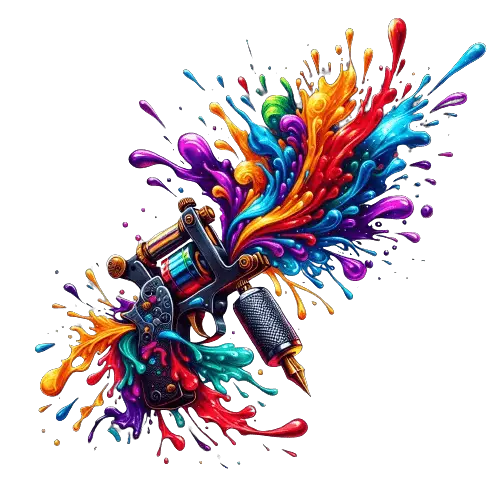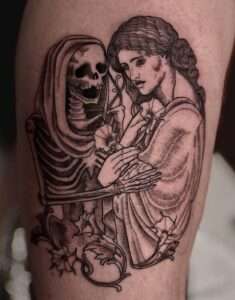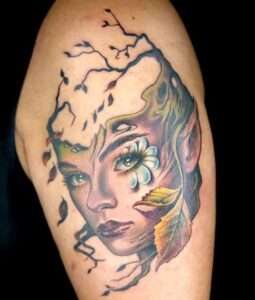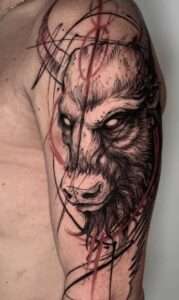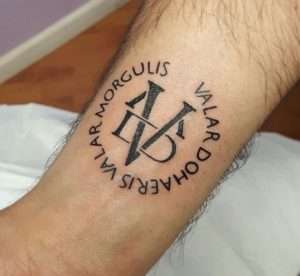Persian tattoos are a form of body art that holds deep cultural and symbolic meanings. In iran, tattoos have a long history and are often associated with Persian mythology and ancient traditions.
These tattoos often feature intricate designs of animals, plants, and mythological figures, each representing a different concept or belief. The meanings behind these tattoos can vary widely, with some symbolizing protection, strength, love, or spirituality. Whether you’re interested in getting a Persian tattoo or simply curious about their significance, understanding their cultural context and symbolism can help you appreciate their beauty and significance even more.
So, let’s explore the world of Persian tattoos and their meanings.
Traditional Persian Tattoo Designs
Persian Tattoos And Meanings
Are you fascinated by the rich cultural heritage of persia? Persian tattoos can be a beautiful way to celebrate the history, traditions, and symbols of this ancient civilization. In this section, we will delve into the world of traditional persian tattoo designs, exploring the meanings behind zoroastrian symbols, mythical creatures, and the influence of persian carpets and patterns.
Zoroastrian Symbols And Their Meanings In Tattoos:
Asho farohar: This symbol, also known as the faravahar, represents the divine guidance and protection of one’s soul. It depicts a winged figure in a dynamic stance, symbolizing the eternal struggle between good and evil. The faravahar is adorned with numerous elements, each with its own symbolic meaning.
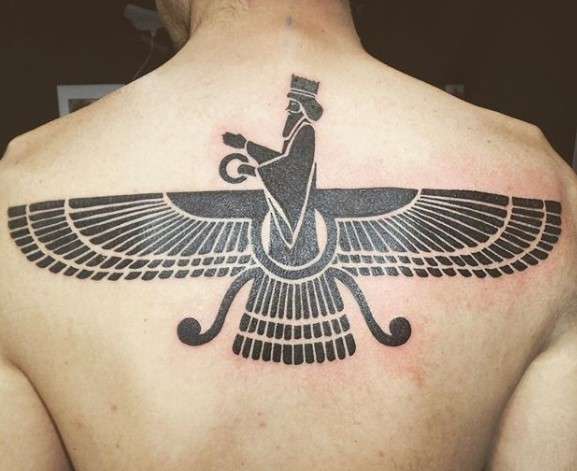
Wings: Signify the ability to ascend to higher spiritual realms.
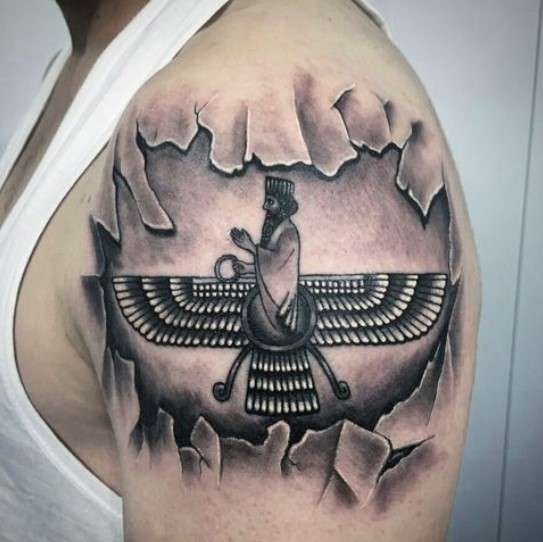
Three layers of feathers: Represent good thoughts, good words, and good deeds.
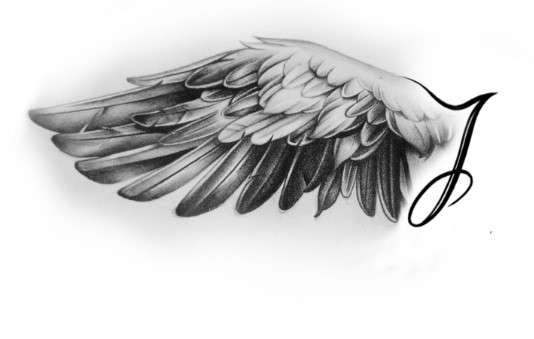
Circle at the center: Symbolizes the divine, unending, and infinite.
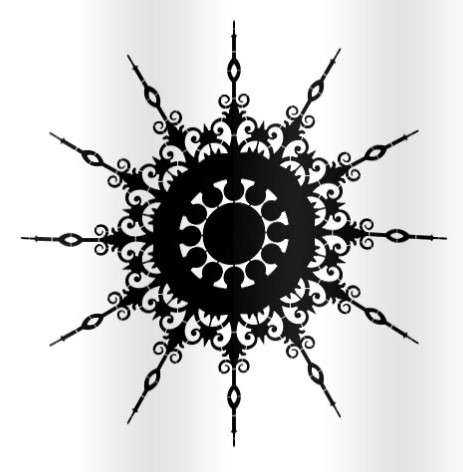
Avestan script: The avesta is the sacred text of the zoroastrian religion and its script holds deep spiritual significance. Incorporating avestan words or verses into a tattoo can be a powerful way to honor the ancient teachings and values they represent.
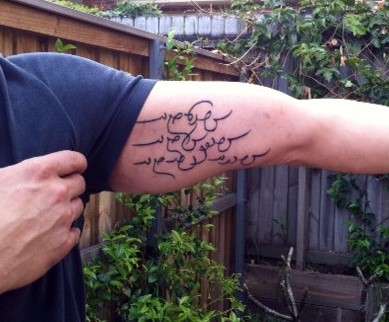
Fravashi: The fravashi is a guardian spirit that guides and protects an individual throughout their life. It is believed to be the divine essence of one’s ancestors, connected to their soul and acting as a source of strength.
Depiction Of Mythical Creatures In Persian Tattoos:
Simurgh: This mythical bird is depicted as a benevolent creature with the head of a dog and the wings of a bird. It symbolizes protection, wisdom, and the union of earth and sky. Simurgh tattoos can be a powerful representation of strength and guidance.
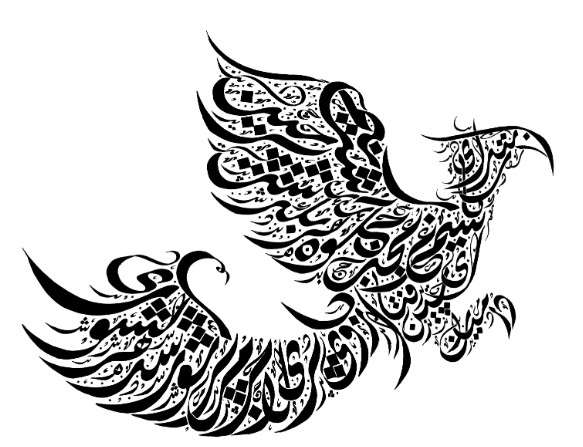
Griffin: A hybrid creature with the body of a lion and the wings of an eagle, the griffin symbolizes courage, power, and protection. In Persian folklore, it was believed to guard treasures and possess great wisdom.
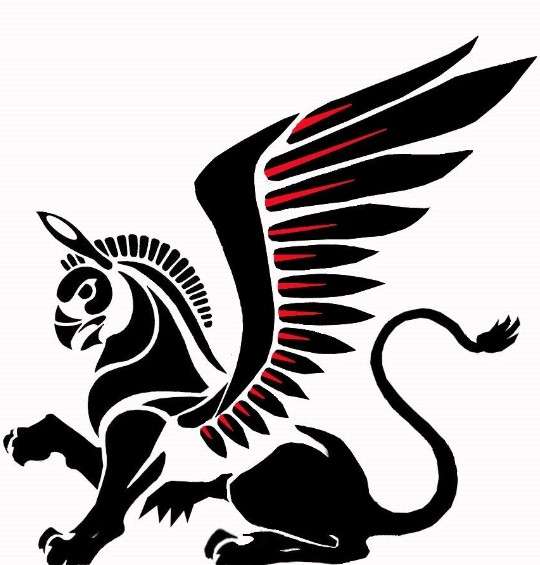
Dragon: Often depicted as a serpent-like creature, dragons in Persian mythology were seen as powerful beings associated with water and fertility. Dragon tattoos can represent strength, wisdom, and transformation.
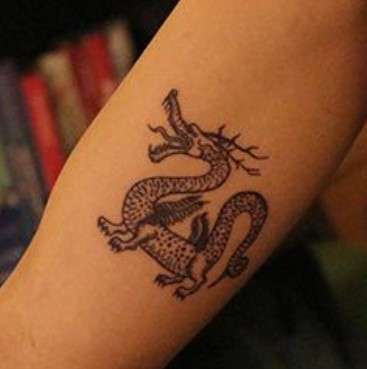
Influence Of Persian Carpets And Patterns In Tattoo Designs:
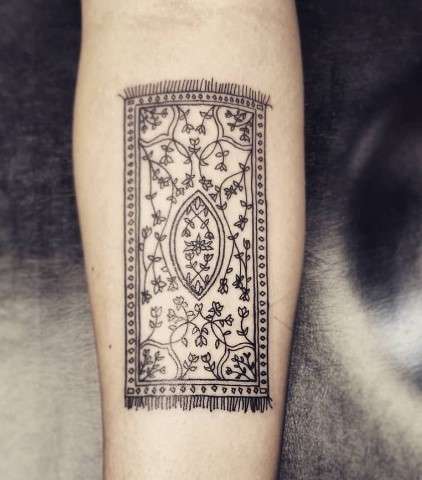
Persian carpets are renowned for their intricate designs and vibrant colors. The patterns found in these carpets have influenced tattoo artists, inspiring unique and beautiful designs.
Geometric patterns: These intricate designs symbolize harmony, balance, and the interconnectedness of all things. Incorporating geometric patterns in tattoos can create visually stunning and meaningful pieces of art.
Floral motifs: Persian carpets often feature intricate floral motifs such as roses, lotus flowers, and palm leaves. These designs can symbolize beauty, growth, and the cycle of life.
By embracing traditional persian tattoo designs, you can pay tribute to the rich history, symbolisms, and artistic heritage of this ancient civilization. Whether you choose zoroastrian symbols, mythical creatures, or patterns inspired by persian carpets, each tattoo can serve as a beautiful reminder of the enduring beauty and significance of persian culture.
Popular Persian Tattoo Meanings
The world of tattoos is a vast and diverse one, with each culture bringing its own unique symbols and meanings to the art form. One such culture that has a rich history of tattooing is persian culture. Persian tattoos are not only visually stunning but also filled with deep symbolism and meaning.
In this blog post, we will explore popular persian tattoo meanings and the symbolism behind some of the most common motifs.
Symbolism Of The Faravahar In Persian Tattoos
The faravahar is a powerful and widely recognized symbol in persian culture. It is often depicted as a winged disc with a male figure at the center, representing the divine guidance and protection of ahura mazda, the supreme god in zoroastrianism.
Here are some key points about the symbolism of the faravahar in persian tattoos:
- The faravahar symbolizes the journey of the soul through life, with the wings representing the choices and decisions one must make.
- The ring within the faravahar represents eternity and the cyclical nature of life.
- The male figure in the center is believed to be the soul, with his three parts representing good thoughts, good words, and good deeds.
- Persian tattoos featuring the faravahar are often chosen as a symbol of spirituality, protection, and guidance.
The Lion And Sun Motif: Power And Bravery
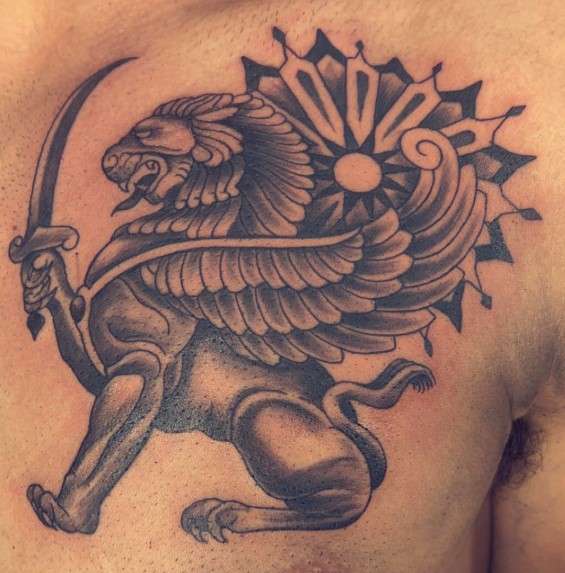
Another popular persian tattoo motif is the lion and sun. This motif features a roaring lion standing in front of a radiant sun, symbolizing power, courage, and bravery. Here are some key points about the lion and sun motif in persian tattoos:
- The lion is a symbol of strength, royalty, and leadership in persian culture.
- The sun represents light, life, and enlightenment, symbolizing the triumph of good over evil.
- Persian tattoos featuring the lion and sun are often chosen by individuals who wish to embody qualities such as power, courage, and resilience.
Floral Motifs And Their Symbolic Interpretations In Persian Tattoos
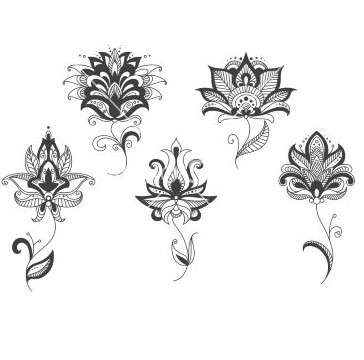
Floral motifs hold significant meaning in persian culture and are commonly incorporated into persian tattoos. Each different flower carries its own symbolism and interpretations. Here are some key points about floral motifs in persian tattoos:
- The rose is one of the most popular floral motifs in persian tattoos and symbolizes love, beauty, and passion.
- The tulip is a symbol of abundance, spring, and renewal in persian culture.
- The lotus flower is associated with purity, enlightenment, and spiritual growth.
- Persian tattoos featuring floral motifs are often chosen as a way to express emotions, embody virtues, or connect with nature.
Persian tattoos are not just beautiful pieces of art but also rich with deep symbolic meanings. From the faravahar representing spirituality and guidance to the lion and sun symbolizing power and bravery, and the various floral motifs embodying different virtues, persian tattoos offer a myriad of choices for individuals looking to express themselves through body art.
Uncovering The Mysteries Behind Persian Tattoo Symbols
Persian Tattoos And Meanings
Persian tattoos are more than just body art – they are a representation of culture, history, and personal beliefs. Each symbol carries its own significance, and these tattoos serve as a way for individuals to express their identity. In this section, we will delve into the intriguing world of persian tattoo symbols, uncovering the mysteries behind them.
The Significance Of Geometric Patterns In Persian Tattoos
Geometric patterns hold great meaning in persian culture, and they are popular choices for tattoos. Here are some key points to understand the significance of these patterns:
- Geometric patterns, such as the famous persian carpet designs, represent the order and harmony found in nature and the universe.
- These patterns are often associated with fertility, protection, and good luck.
- Persian geometric tattoos are visually captivating and can be customized to reflect the individual’s personality and style.
Divinity And Spirituality In Persian Tattoo Symbols
Persian culture is deeply rooted in spirituality and a reverence for the divine. When it comes to persian tattoo symbols, divinity and spirituality play a vital role. Here are some important aspects to consider:
- Symbols like the farvahar, which depict a winged figure, represent the zoroastrian faith and the eternal battle between good and evil.
- Other popular divine symbols include the lion and the sun, which are associated with power, kingship, and divine protection.
- Persian tattoo symbols related to divinity and spirituality can serve as a personal reminder of faith and the connection to something greater than oneself.
Hidden Messages And Secret Meanings In Persian Script Tattoos
Persian script tattoos are a beautiful way to convey messages, names, or meaningful phrases. However, they can also carry hidden messages and secret meanings. Here is what you should know:
- Calligraphy in persian script is an art form in itself, with each stroke and curve holding significance.
- Persian script tattoos can contain poetic verses, personal mantras, or even secret messages that hold deep meaning to the individual.
- These tattoos allow for self-expression, while also keeping the messages within them private and concealed.
In Conclusion
Persian tattoo symbols are rich in history, culture, and symbolism. Whether it is the intricate geometric patterns, divinity-inspired symbols, or hidden messages in persian script, each tattoo carries a unique and deeply personal meaning. These tattoos provide individuals a way to express their identity, beliefs, and their connection to persian heritage.
So, if you’re considering a persian tattoo, take the time to explore the different symbols and discover the one that resonates with you the most.
Persian Tattoo Artists: From Traditional To Contemporary
Persian tattoo artists have a rich history and a growing influence in the global tattoo scene. From traditional motifs to contemporary styles, these artists bring a unique perspective to the art of tattooing. Let’s dive into the world of persian tattoo artists and explore their impact on the industry.
Influential Persian Tattoo Artists And Their Unique Styles
- Raqib shaw: This london-based artist draws inspiration from persian miniatures and creates intricate and vibrant pieces. Shaw’s tattoos often feature mythical creatures and ornate patterns, reflecting his persian heritage. His work has gained recognition worldwide for its meticulous detail.
- Sophia baughan: Drawing upon traditions and symbolism from persian culture, baughan blends dotwork and blackwork techniques to create stunning geometric tattoos. Her style is known for its intricate designs and attention to detail, capturing the essence of persian aesthetics.
- Reza ghobadi: With a background in calligraphy and persian metalwork, ghobadi has developed a distinct artistic style that incorporates fluid lines, intricate patterns, and cultural references. His tattoos often depict persian poetry and mythology, embodying the spirit of persian heritage.
Fusion Of Traditional Persian Motifs With Modern Tattoo Techniques
- Persian tattoo artists are adept at blending traditional persian motifs with modern tattoo techniques, resulting in unique and captivating designs. By combining ancient symbols and contemporary elements, these artists create tattoos that resonate with both cultural significance and personal expression.
- Using techniques such as linework, dotwork, and shading, persian tattoo artists breathe new life into traditional patterns and symbols. They blend the old with the new, preserving the rich heritage while adapting to modern artistic styles.
Impact Of Persian Tattoo Artists On The Global Tattoo Scene
- Persian tattoo artists have made a significant impact on the global tattoo scene, introducing a fresh perspective and unique cultural influences. Their work challenges traditional tattoo boundaries and expands the artistic possibilities within the industry.
- Through the global exposure of social media and tattoo conventions, persian tattoo artists have gained recognition for their exceptional craftsmanship and artistic vision. Their work has inspired countless tattoo enthusiasts and fellow artists worldwide.
- By incorporating persian motifs, symbols, and aesthetics into their designs, these artists have brought a fresh perspective to the tattoo industry. They give individuals an opportunity to express their connection to persian culture and heritage through body art.
Persian tattoo artists are a force to be reckoned with, showcasing their unique styles and influencing the global tattoo scene. Their fusion of traditional persian motifs with modern tattoo techniques has created a new realm of possibilities for tattoo enthusiasts.
With their exceptional craftsmanship and artistic vision, persian tattoo artists continue to leave a lasting impact on the industry.
Popular Spots For Persian Tattoos
Persian Tattoos And Meanings
Meaningful Placement And Its Relationship To Symbolism
When it comes to persian tattoos, the placement of the tattoo holds great significance as it plays a vital role in conveying the intended meaning and symbolism. Here are some key points to consider:
- The choice of placement for a persian tattoo is often deliberate, reflecting the symbolism behind the design and the personal meaning attached to it.
- Certain body parts have traditionally held deeper symbolism in persian culture. For example, a tattoo placed on the wrist is believed to bring protection and ward off evil forces.
- The placement of a persian tattoo can also be influenced by the desired message. Placing a meaningful persian phrase on the ribcage, for instance, signifies a personal connection and the desire to keep it close to one’s heart.
- The relationship between the placement and symbolism of a persian tattoo is highly individual, allowing individuals to express their unique perspectives and values through their choice of placement.
Cultural And Religious Considerations In Persian Tattoo Placement
Persian culture is deeply rooted in its rich heritage and religious beliefs. When selecting the placement for a persian tattoo, cultural and religious considerations come into play. Here are a few important points to keep in mind:
- In persian culture, modesty is highly valued. As a result, tattoos on exposed body parts may be considered inappropriate or disrespectful, especially in more traditional settings.
- Religious beliefs, such as islam, also affect tattoo placement. Islam generally views tattoos as a form of alteration to the body, which is discouraged. As a result, many persians choose discreet placements that can be easily covered, such as the back or upper arm.
- Moreover, cultural traditions and personal preferences may influence the placement of a persian tattoo. Some individuals opt for placements that align with persian art and calligraphy, such as the shoulder or thigh, as a way to honor their heritage.
Contemporary Trends In The Placement Of Persian Tattoos
With the evolving nature of tattoo culture, contemporary trends have emerged in the placement of persian tattoos. Here are some notable trends to be aware of:
- Persian tattoos are increasingly being placed on easily visible areas, such as the forearm or ankle, as a way to proudly showcase one’s persian heritage.
- Minimalist designs that incorporate persian calligraphy or symbols are often placed on more delicate areas, including the wrist or behind the ear, for a subtle yet meaningful statement.
- Mixing traditional placement with modern motifs is another trend in persian tattooing. For example, combining a traditional persian symbol with a modern geometric design and placing it on the back or calf can create a unique aesthetic blend.
- Ultimately, the placement of a persian tattoo is a personal choice influenced by individual preferences, cultural backgrounds, and the desire to make a statement that reflects one’s identity.
Persian Tattoos: Misconceptions And Stereotypes
Persian tattoos have gained popularity in recent years as more people become intrigued by the rich cultural heritage of persia. However, there are several misconceptions and stereotypes surrounding persian tattoo art. In this section, we will debunk these myths, discuss cultural appropriation and respect for persian tattoo art, and highlight the importance of creating awareness and appreciation for persian tattoo culture.
Debunking Myths And Misconceptions About Persian Tattoos
- Myth: All persian tattoos have the same meaning.
- Contrary to popular belief, persian tattoos can have a wide range of meanings, just like any other form of tattoo art. Each design is unique and can symbolize different aspects of persian culture, such as spirituality, love, strength, or freedom.
- Myth: Persian tattoos are only for persians.
- Persian tattoo art is not exclusive to persians, and anyone can appreciate and embrace this art form. Tattoo enthusiasts from different cultural backgrounds can pay homage to persian culture by getting a persian-inspired tattoo, as long as they do it with respect and appreciation.
- Myth: All persian tattoos are elaborate and intricate.
- While persian art is often characterized by its intricacy and attention to detail, not all persian tattoos are overly elaborate. There are simpler designs that still capture the beauty and essence of persian culture. It is up to the individual to choose a design that resonates with them.
Cultural Appropriation And Respect For Persian Tattoo Art
- Understanding cultural appropriation:
- Cultural appropriation refers to the adoption or borrowing of elements from another culture without understanding or respecting their significance. It is essential to approach persian tattoo art with cultural sensitivity and respect, rather than appropriating it for superficial or trendy purposes.
- Recognizing the importance of respect:
- Before getting a persian tattoo, it is crucial to research and understand the cultural, historical, and symbolic meanings associated with the design. This knowledge helps in respecting the art form and ensuring that the tattoo is a genuine representation of persian culture.
- Consulting with a professional artist:
- To ensure cultural respect and accuracy, it is advisable to work with a professional tattoo artist who is knowledgeable about persian art and culture. They can guide you in choosing a design that honors persian heritage while respecting the artistic integrity.
Creating Awareness And Appreciation For Persian Tattoo Culture
- Sharing knowledge and stories:
- Educating others about the rich history and symbolism behind persian tattoo art can help dispel misconceptions and stereotypes. Share relevant information, anecdotes, and personal experiences to foster a deeper appreciation for this unique art form.
- Promoting cultural exchange and dialogue:
- Encourage open conversations and respectful interactions between individuals from different cultural backgrounds. This exchange of ideas and perspectives can lead to a better understanding and appreciation of persian tattoo culture.
- Supporting persian tattoo artists:
- Show support and recognition for persian tattoo artists by promoting their work and giving credit where it is due. Attend tattoo conventions, art exhibitions, or workshops that celebrate persian tattoo artistry.
By debunking myths, understanding cultural appropriation, and promoting awareness and appreciation, we can cultivate a deeper understanding of persian tattoo culture. Let us embrace this art form with respect and share its beauty with the world.
Frequently Asked Questions On Persian Tattoos And Meanings
What Do Persian Tattoos Symbolize?
Persian tattoos symbolize cultural heritage, spirituality, love, strength, and personal beliefs of individuals.
Are Persian Tattoos Painful?
The pain level of persian tattoos varies depending on the placement, size, and individual’s pain tolerance.
How To Choose A Meaningful Persian Tattoo Design?
Research persian symbols, motifs, and their meanings to find a design that resonates with your personal story or values.
Conclusion
Persian tattoos are a captivating representation of the rich history and culture of iran. With their intricate designs and deep symbolic meanings, these tattoos have gained popularity among people around the world. From the ancient persian script to the iconic birds and floral motifs, each tattoo holds a unique story and significance.
The beauty of persian tattoos lies in their ability to blend artistry with personal expression. Whether it’s a tribute to one’s heritage or a way to embrace the timeless wisdom of persian culture, these tattoos offer a powerful means of self-expression.
So, if you’re considering getting a persian tattoo, take the time to explore the various designs and meanings. Immerse yourself in the beauty and depth of persian art and allow it to inspire your own unique inked masterpiece. Let your persian tattoo be a testament to the timeless allure and lasting impact of this ancient civilization.
